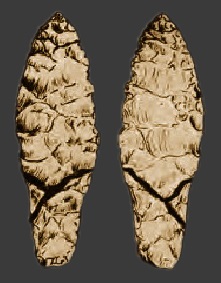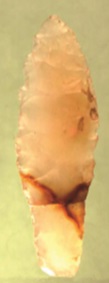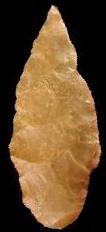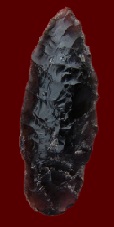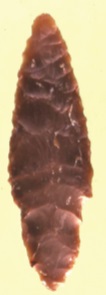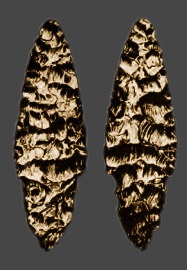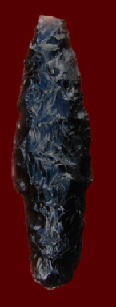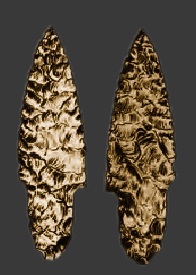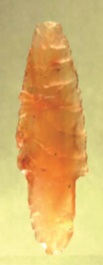Outline is Representative of Size and Shape:

Name Details:
Identified By: Richard D. Dougherty
Named For: Type Site
Date Identified: 1956
Type Site: Lind Coulee site (45GR97), Grant County, Washington
Identified By: Richard D. Dougherty
Named For: Type Site
Date Identified: 1956
Type Site: Lind Coulee site (45GR97), Grant County, Washington
Point Validity:
Valid type
Dougherty was a well-respected and distinguished anthropologist and professor of Anthropology at Washing State University. He was an expert on the archaeology of Washington. His work with the Makah Tribe created a new standard for Native American and archaeological cooperation. This type was named in a professional publication and has many professional references. This is considered a valid type
Dougherty was a well-respected and distinguished anthropologist and professor of Anthropology at Washing State University. He was an expert on the archaeology of Washington. His work with the Makah Tribe created a new standard for Native American and archaeological cooperation. This type was named in a professional publication and has many professional references. This is considered a valid type
Lind Coulee Stemmed
Cluster: Northern Pacific Stemmed Cluster Description of Physical Characteristics and Flaking Pattern:
This is a medium to large triangular stemmed point with an elliptical cross section. The blade varies from excurvate to straight. The shoulders may range from weak to absent and may be at an upward angle or horizontal. The stem is long and straight or slightly contracting with a convex base. Basal grinding is commonly seen on this point. This point is manufactured using broad percussion flaking with a finishing pressure flaking commonly obscuring the primary flaking forming a random to parallel horizontal flaking pattern.
Size Measurements:
Total Length - 46 to 132 mm, Stem Length - 18 to 41 mm, Blade Width - 18 to 39 mm Stem Width - 14 to 29 mm, Thickness - 4 to 5 mm
Total Length - 46 to 132 mm, Stem Length - 18 to 41 mm, Blade Width - 18 to 39 mm Stem Width - 14 to 29 mm, Thickness - 4 to 5 mm
Commonly Utilized Material:
Additional Comments:
Dougherty (1956) identified three types of the Lind Coulee point:
Type 1: This is a long slender point with weak shoulders that are rounded with a long contracting stem and a convex base.
Type 2: This is a triangular shaped point with prominent shoulders that are horizontal to having an upward angle. The stem is slightly contracting with a convex base.
Type 3: This is a triangular point with shoulders that may vary from prominent to weak and a straight stem with a convex base.
This point is thought to have co-exist with the Clovis point. It is thought to be one of the oldest early stemmed points, being about 1,000 years older than the Parman point.
Dougherty (1956) identified three types of the Lind Coulee point:
Type 1: This is a long slender point with weak shoulders that are rounded with a long contracting stem and a convex base.
Type 2: This is a triangular shaped point with prominent shoulders that are horizontal to having an upward angle. The stem is slightly contracting with a convex base.
Type 3: This is a triangular point with shoulders that may vary from prominent to weak and a straight stem with a convex base.
This point is thought to have co-exist with the Clovis point. It is thought to be one of the oldest early stemmed points, being about 1,000 years older than the Parman point.
Distribution: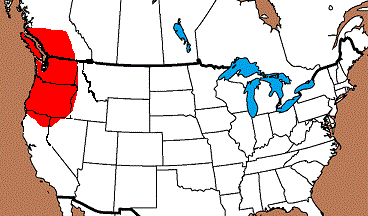
Distribution Comments:
This point is primarily found in the Columbia Plateau of Washington and Oregon and into western Idaho. This point is found into the Cascade range of Oregon and into northern Great Basin. This point has been reported into the Columbia Frazier Plataea in British Columbia, but the extent and exact distribution was not reported.
This point is primarily found in the Columbia Plateau of Washington and Oregon and into western Idaho. This point is found into the Cascade range of Oregon and into northern Great Basin. This point has been reported into the Columbia Frazier Plataea in British Columbia, but the extent and exact distribution was not reported.
Age / Periods:
Date: 10,500 - 9,000 B.P.
Cultural Period: Transitional Paleo
Glacial Period: Late Pleistocene to Early Holocene
Culture: Old Cordilleran Culture
Date: 10,500 - 9,000 B.P.
Cultural Period: Transitional Paleo
Glacial Period: Late Pleistocene to Early Holocene
Culture: Old Cordilleran Culture
Age Details:
Similar Points:
Cascade Shouldered, Cougar Mountain, Early Stemmed, Haskett, Lake Mojave, Lochnore, OYKC Stemmed, Parman, Silver Lake, Taan, Windust
Cascade Shouldered, Cougar Mountain, Early Stemmed, Haskett, Lake Mojave, Lochnore, OYKC Stemmed, Parman, Silver Lake, Taan, Windust


